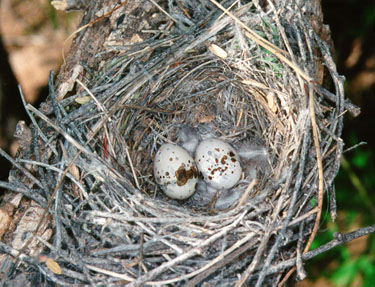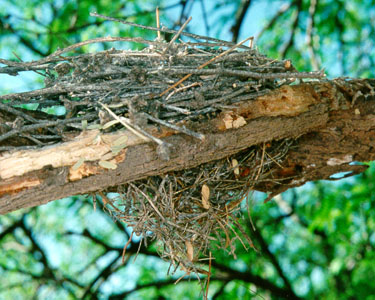Vermilion Flycatcher Nest With Eggs, Photographs by Greg Clark
 Typically, Vermilion Flycatchers build their nests in a horizontal tree branch fork way up in a high tree. Occasionally, when big trees are not available, they will build lower and so the contents of the nest can be directly observed and photographed. Note the liberal use of feathers to line the nest and the beautifully marked eggs.
Typically, Vermilion Flycatchers build their nests in a horizontal tree branch fork way up in a high tree. Occasionally, when big trees are not available, they will build lower and so the contents of the nest can be directly observed and photographed. Note the liberal use of feathers to line the nest and the beautifully marked eggs.
 This photograph shows the characteristic conical shape of the Vermilion Flycatcher nest when viewed from the side. Note that the nest is built in a horizontal fork. Once Tim and I observed a female Vermilion flying back and forth from a bush to a nest site with no seeming purpose. We changed our angle of view and then could see the spider webs she was carrying as they caught the sunlight. Nest construction will vary, depending on local materials available, showing that some birds have an intelligent craftsmanship. Otherwise, they would get stuck if a certain material wasn't available.In the nest photo on the previous page a blue thread (similar to the blue material seen in the Bendire's Thrasher nest photograph on another part of the web site) can be seen that was added after the above photo was taken. (The photos are a week apart). The blue thread might be taking the part of a spider web that would be used in another area. It is possible to put out various materials for the birds to use around your home and see what disappears. You can try yarn, string, human and animal hair, easter egg basket green grass, cotton balls, and strips of cloth cut into very thin strips. Different colors might also be something to experiment with. Who says water and seed are the only kinds of feeders? Put out a nest material "feeder" and see what happens.
This photograph shows the characteristic conical shape of the Vermilion Flycatcher nest when viewed from the side. Note that the nest is built in a horizontal fork. Once Tim and I observed a female Vermilion flying back and forth from a bush to a nest site with no seeming purpose. We changed our angle of view and then could see the spider webs she was carrying as they caught the sunlight. Nest construction will vary, depending on local materials available, showing that some birds have an intelligent craftsmanship. Otherwise, they would get stuck if a certain material wasn't available.In the nest photo on the previous page a blue thread (similar to the blue material seen in the Bendire's Thrasher nest photograph on another part of the web site) can be seen that was added after the above photo was taken. (The photos are a week apart). The blue thread might be taking the part of a spider web that would be used in another area. It is possible to put out various materials for the birds to use around your home and see what disappears. You can try yarn, string, human and animal hair, easter egg basket green grass, cotton balls, and strips of cloth cut into very thin strips. Different colors might also be something to experiment with. Who says water and seed are the only kinds of feeders? Put out a nest material "feeder" and see what happens.
Copyright Greg Clark, 2000
update 8/2012